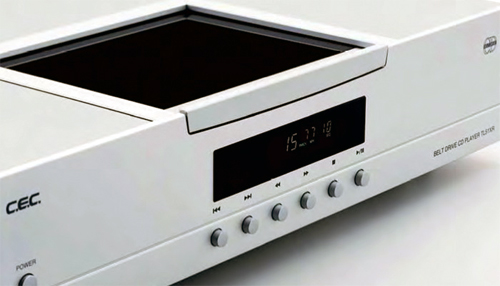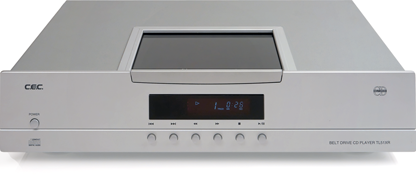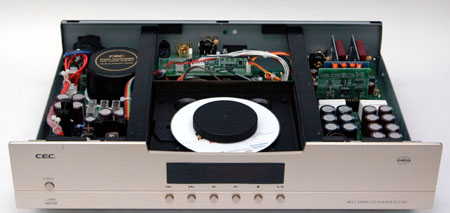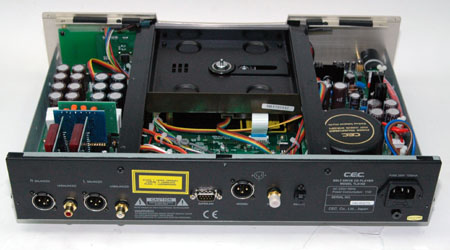
You are reading the older HTML site
Positive Feedback
ISSUE
27
c.e.c.
TL 51XR CD player
as reviewed by Larry Cox

|
LARRY COX'S SYSTEM
LOUDSPEAKERS
ELECTRONICS
SOURCE
CABLES
ACCESSORIES
|
As both Mutine and Bruce Kennett know—Bruce Kennett is Mutine's nominal US representative—it has taken a long time to write this article for the simple reason that it required a lengthy time to work out a fair description of the listening experience. For a starting place, this is an excellent Redbook CD player. Perhaps it is a tired division, but the C.E.C. TL 51XR will appeal to music lovers who appreciate high resolution, which will remind them why they love music. On the other hand, detail freaks will probably miss its special balance of detail and emotion.
It is difficult to explain or describe how a player this inexpensive (even though $1690 is a fair sum) can be such a subtle and seductive bringer of music. This is a very polished player that competes with the best, and I do mean the best, in terms of conveying the subtleties and nuances that makes our music so involving. As opposed to a sound that is "interesting" as in being more like an autopsy—that is some gear only delivers detail and sound. Cost no object players will present detail a bit more easily, perhaps the bass will be better and the midrange and top end might seem a bit more clearly presented, but the TL51XR will seem to not be cut from a very different cloth.
Over the short two months with the C.E.C. spinning discs, I found this player to be quite involving. Even so, my initial impression was that the TL51XR was a little too laid back and perhaps softer sounding, though its gentle, firm way with music invited me to listen into the music more deeply than with other players. I found myself over time releasing listening defense mechanisms of which I had been previously unaware. Doing so allowed gobs and gobs of detail to be available for scrutiny, without any worry of an aural assault slipping through my dropped defenses. What sort of detail?
Not the sort of detail that detail freaks demand. The "detail freak" iteration of an audiophile seems to want to hear all detail with equal clarity. In highlighting everything, one effectively highlights nothing. What is music, if not some musical elements in the foreground (highlighted) and some in the background (low-lighted)?

The detail that the TL51XR does provide is well illustrated in hearing "Unnamed" from Pepe and the Bottle Blondes' Late Night Betty. Pepe and the Bottle Blondes are Pepe Raphael and several female singers, along with a healthy collection of instrumentalists. They sing an upbeat variety of Latin flavored music with gorgeous vocalizations. The harmonizing in what is the most beautiful song featuring a female duet, "Unnamed", is unmatched on any piece of music I have heard, including the audiophile drivel on which many audiophiles have cut their teeth.
On every system I have heard this duet singing, including every iteration of my own over the past four years, I've never heard the slightest indication that the pair or trio of female vocalists are not exactly (and I do mean exactly) in sync and at the exact volume level. Included in my list of gear, are CD players ranging in price from $495 to a pair of $15,000 CD players. Contextually those two $15,000 players were excellent sounding players too. I am not comparing the C.E.C. to overpriced, lousy performers.
Through the C.E.C. TL51XR, I heard for the first time, the engineer's subtle modulation of the volume levels of the vocalists. The amount of modulation is very slight, yet out of the reach of some excellent CD players. The effect is to appreciate perhaps even more, the vocalists' excellent harmonizing skills. What I heard is not only an ability hit and sustain the same note, but to do so seemingly at the exact same time and nearly at the exact same volume level. That they "failed" only at the volume level allows me to appreciate their excellence, but reminds me of the skills of all performers. In my world, if not yours, this sort of musical information/detail brings me closer to a "live" performance. This is musical information I enjoy hearing.
Okay, let's backtrack a bit so I can give you some dope on C.E.C. You may not have heard much about C.E.C., but you have heard about products for which C.E.C. has been an OEM manufacturer: e.g. SME and Oracle turntables. C.E.C. has made tone arm bearings, motors, and power supplies for SME's turntables, and produced Oracle's turntable bearings. They have been a part of some highly regarded products and have demonstrated the ability to produce high quality products of their own.
It is not surprising that C.E.C. is associated with SME and Oracle, as at C.E.C.'s start in 1954 they made turntable motors, and did so for many years thereafter, mostly as an original equipment manufacturer. They are a large entity based in Tokyo, and one of a few companies that make CD motors, along side Sony, Philips, Pioneer (their stable platter), and TEAC (Esoteric). That again puts them in pretty remarkable company.
My interest in C.E.C. arose during a conversation with a North American service rep for a well-known high-end audio company—this individual is not a C.E.C. repair technician. Apparently, C.E.C. is nearly alone in providing CD drives that are drop in replacements for units that have failed. The reason is in part that manufacturers that rely on Sony or Philps based drives are subject to constant "upgrades" of their drive unit as many as two times a year; the upgraded designs aren't "drop in" replacements and require some re-engineering for replacement. C.E.C.s are quite robust and remain drop in replacements. I found that desirable.

The top loading C.E.C. TL-51XR is of course belt-driven. The motor is said to be a low-torque motor that spins a relatively heavy "puck" sitting on top of the spindle. Made of a ceramic material, the puck is larger and heavier than any puck I have seen used on other CD players. Ceramics are touted as having superior damping qualities. The weight of the puck generates a flywheel effect by adding a large initial moment. Once or twice, I lifted a CD without removing the puck first and the puck's weight noticeably bowed the CD.
Digital duties are done by Burr Brown PCM 1796 DAC. I'm a little confused by C.E.C.'s brochure as it indicates that there is only one DAC chip and that it operates in "dual mono". The latter nomenclature leads me to think that there is one 1796 DAC per channel, while the former seems to say there is only one DAC. Bruce Kennett indicates that he believes that each side of the DAC has a separate power supply. In any event, C.E.C. asserts that the dual mono implementation guarantees "ultra low distortion, high dynamic range and channel separation". The DAC upsamples to 192 kHz. The digital filter works in a delta sigma configuration for the "best dynamic performance, lowest distortion, and increasing the linearity at the lowest level".
C.E.C. uses what it calls a landmark technology, "current injection" (CI) which is said to shorten the signal path. CI is said to require a non-negative feedback amplifier and replaces the voltage amplifier, which would otherwise normally be present. Okay, I am a lawyer, not an engineer, so I have no idea what the hell most of that means.
What I can state about the balanced configuration is that the balanced outputs (XLR) sound great, much better than the unit's RCA outputs. The XLR outputs are dual differential circuits and share no grounding. If you should decide to deploy the TL 51XR as a transport, it offers Toslink, AES/EBU and "Superlink" (C.E.C.'s 9 pin connector) for digital outputs. Okay, that is a bucket of detail that may well fly above the heads of most readers, and certainly over mine. I wanted to give C.E.C. its technical "due" as all that technical stuff results in a truly excellent product - not just for the money, but at any price.

Rather than drag you through a bass, midrange, and treble description, I will try a different route. Like ATC speakers whose virtues I have extolled for many years, I find the attributes that I really value in music reproduction to be similarly present in the C.E.C. player, though in differing measures. Moreover, the C.E.C.'s excellence reminded me of what my sonic priorities are, as its strengths are the strengths I value most in audio.
Let me digress for a moment here. In the early days of my sickness, er, audiophile pursuit, I found myself in the component upgrade lust, considering disparate "excellent" components. My attraction to "everything" was largely because I was unaware of what was my "hierarchy" of musical values. As a reviewer I have heard enough different components that I now easily understand and differentiate the nice from the necessary—this allows me to prioritize even amongst those deemed necessary qualities.
Like many of you, I can tell within a few seconds of listening whether the component is even worth considering. Clearly those few seconds aren't enough to know that I'm going to really like a product, but those few seconds have culled a lot of products from my review list. I think learning what is musically significant to listeners is vital to satisfaction if not happiness in this hobby, and is more important than any reviewer's opinions or conclusions.
Okay, back to how the C.E.C. TL 51XR's performance is in the sweet spot of my musical values. My three values are timbral accuracy; macro-dynamic speed, and enough detail to be able to hear who is doing what in a recording—and in that order. It may seem awfully simplistic, but like I said, having that at my disposal has saved me a lot of time and helped me choose well.
Across all three of my highest priorities, the over-arcing and immediately noticeable desirable quality I heard from the TL 51XR is the wholesomeness, as in the whole of a musical experience being reproduced in my room. There was no sense an artificial amplification of certain attributes to obtain their attention. The player communicated a rare sense of the light from within music that makes a live event so involving. This led me to articulate concisely my "hierarchy" of musical attributes.
The first individual parameter of importance to me is timbral "accuracy". If I can be misled into hearing what could pass for the timbre of the instrument being replayed, the car gets out of the garage; otherwise, I will park it and walk. This attribute is absolutely the sine qua non of satisfaction and far outstrips any other individual parameter. If a component does not pass this test, the rest of its attributes are irrelevant.
The TL 51XR is rich sounding and perhaps a bit dark. It can deliver bass as a dark growling warmth, except when that deep bass also has a slight golden glow to it. It plumbs the nether regions going nearly as deeply as anything I have heard, while still delivering different textural qualities at different frequencies. The TL 51XR's bass was amongst the best I have heard in revealing different bass timbre. When played loud enough, the C.E.C. delivered a terrific growl that was not only felt but is also heard live—exceeded by only one player in my experience.
There was also the palpable, chesty, and wet sound that the deeper male voices possess and a lighter, more nasal quality to top of the throat range reflective of most female singers. Percussion had the light within the snap that one usually experiences with live music. In short, from top to bottom, the C.E.C. provided a saturation of timbre from all music it spun in my room.
Short comings? Well the bottom end had an analogue-like quality to it, which is to say that it was not washboard abs tight, but more like the "abs" of someone who is in shape and likes to eat, as opposed to one who likes to count calories. Bass was perhaps a bit thicker than thin, but the midrange and treble timbre were excellent, excellent, and excellent. Using a light/dark dichotomy, the TL 51XR was a bit darker than lighter, which is generally consistent with a richer rendering of music. While the treble and midrange had their flaws, I'll discuss them under a different heading.
Next, I listen for a realistic portrayal of the macro-dynamic swing of an instrument; can the component deliver big, yet fast, macro-dynamics without affecting timbre? This is difficult to do. Horns do macro-dynamics really well, perhaps better than any speaker design, but their timbre almost always seems so terribly wrong that I can barely appreciate any other attributes they may possess. This failing is why I have reviewed only one horn driver speaker in eleven years. Enough said.
While not being as obviously dynamic as properly powered ATC speakers - which are the best in the world in my book—the TL 51XR didn't obviously truncate sound. Music had good "splash" especially in the deeper bass range. For example, on Los Lobos' "Kiko And The Lavender Moon" from the CD Kiko, the kick drum had the appropriate dynamics without needing to be pumped up volume-wise so that one feels the "you are there" punch in the stomach. The player provided the appropriate "elasticity" to the information, from the beginning of the kick to its decay. The same was true for the tuba on Peter Gabriel's "Slowburn" from his first album.
Again, the midrange and treble were not as obviously dynamic but I did not detect any obvious discontinuity of the dynamics within the rest of the range of its performance—call it good integration. Perhaps not as excellent in the other regions of music, but the dynamics were good enough not to detect problems or to be interpreted as being "held back". Good marks for the TL 51XR.
Third, I want to hear the detail that provides cues signaling the start and stop of instruments' timbre. Yeah, this is the attack and decay of music. I normally pooh pooh audiophiles' exaggerated attention to attack and decay, but when they are well integrated to timbre and dynamics, detail becomes a relevant attribute of music. Detail alone just does not deserve to be weighted with timbre and macro-dynamics in my hierarchy, and warrants yet another drop in importance.
Like live bass, and unlike some digital performers, the start and stop of bass was indistinct, rising from nothing-ness to a ripe bass line and then relatively quickly disappearing in time for the next note. On some recordings, like Fleetwood Mac's Rumours the bass seemed slower than it did on the E.A.R. Acute CD player, but it was not consistently "slow". It just had that quality in letting you know when music was slower than "normal."
As to upper midrange and treble detail, go back to my comments on "Unnamed" by Pepe and the Bottle Blondes for how well it did with the micro-details that brought me to the original event. Clearly, it allowed what I felt was an important attribute to shine through. However, if I were to register a complaint about the C.E.C. TL 51XR it would be about the detail in the upper midrange and treble. It is not that there was insufficient detail, but that on first listening, its presentation of detail seemed softer and lacking some of the sparkle that is present live and with the best CD players.
If there were a bit more splash and sparkle here, perhaps I would be shouting about the excellent detail of the player. And this sense of slightly reduced detail is the one slight failing, if it is even that. It is also possible that with a different power cord or a different collection of interconnects I could have produced an even better sound. Despite what readers may think, reviewers and this reviewer in particular, do not have cables of every sort to choose from in testing out a component. So it goes.
For context, in my pantheon of favorite CD players, the TL 51XR comes in second place, with first and third places being occupied players that are far more expensive. In first place is the E.A.R. Acute CD Player. At $5495, it should sound better. Where the E.A.R. exceeds the TL 51XRs performance, is in the bit of sparkle of live music. What makes the Acute unusual in my experience is that the micro-dynamic detail that can be part of transparent sound, comes across as being round and liquid, not dry and sharp. The Acute is very good, but it is not three times better—perhaps only ten percent better.
The third place player is Ensemble's Dirondo transport and Dichrono DAC combination. The Ensemble pair are quite excellent and exceeds the Acute in its clarity and precision of musical line, though it lacked some of the loveliness, for lack of a better term, that the Acute player and TL 51XR share. Then again, the Swiss pair delivered the best bass line I have heard from any digital component, bar none. Oh, and at the time of the review, the European pair retailed for $15,000.
To keep the context I have in mind when reviewing, any of the three players could be better than the others in the right system. This hobby is still about synergy, even though individual reviews might promote "super components" that will rescue a poorly constructed system.
Some writers are bothered by bloated pianos that stretch between the speakers, or by images that are "small" or are not proportionate in some fashion; I could not care less. I have never thought about imaging at a live event; most of the time there just is not any "imaging" to be concerned about. I will take a product that gets timbre and macro-dynamics correctly but images poorly one hundred times out of one hundred over a piece with images cut by a razor that's lean with great macro-dynamics. (read horn driven speakers)
This review was intended to express my deep appreciation for the C.E.C. TL 51XR. Is it perfect? No, but it does join the pantheon of a few select components that have bowled me over with their excellence: ATC's SCM20s and SCM50As loudspeakers, and now my current GamuT L5 loudspeakers come to mind. In the realm of electronics, I have loved my E.A.R. Yoshino 864 and 509 amplifiers, as well as the ATC SPA 200P and Lamm LL2 preamplifiers.
Do I recommend the C.E.C. TL 51XR? Absolutely. At $1690, it is a best buy and would still be at twice its price. You get detail the way it is heard live, from the audience, rather than with your ear humping the microphone as heard from many "detailed" components. You get excellent timbral accuracy, very acceptable macro-dynamics, and all the detail I think is necessary to being fooled for a moment or two that you are hearing music, rather than a recording. This is delicious stuff for music lovers. Larry Cox
TL 51XR CD player
Retail: $1690
North American Distributor
Mutine
web address:
http://mutine.com
